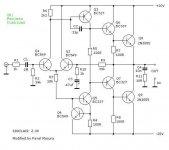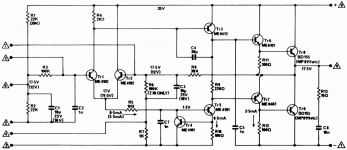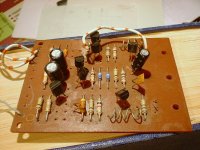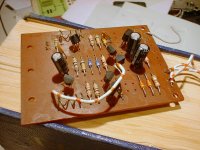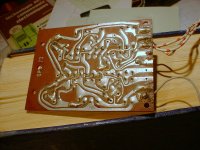I've never owned any Sinclair audio gear, although I was tempted by an integrated amp around 1978. Foolishly or luckily, I chose to scratch build an amp and preamp in my dorm room instead, including rewinding a power transformer.
I did build a Sinclair scientific calculator kit, though. It was a challenge to my primitive soldering skills (and iron), but it worked. However, the power switch was a flimsy slide switch, and it tended to switch itself off at inopportune moments. The Commodore programmable calculator that replaced it was a much more impressive example of British design.
I did build a Sinclair scientific calculator kit, though. It was a challenge to my primitive soldering skills (and iron), but it worked. However, the power switch was a flimsy slide switch, and it tended to switch itself off at inopportune moments. The Commodore programmable calculator that replaced it was a much more impressive example of British design.
Last edited:
A couple more links with lots of schematics but not all sinclair.
second link not in english.
4QD TEC Circuits Archive
Audioweb.cz Fórum / Chronologicky
second link not in english.
4QD TEC Circuits Archive
Audioweb.cz Fórum / Chronologicky
I have worked on a lot of Sinclair stufff in the past the link in the previous post to the Neoteric is great I remember working on those a superb piece of design in the cosmetic sense
He really was a clever Guy re marketing
What Clive sold was aspiration Quality at a price
He was worth a bucketfull of gold for the imagination and insperation that he sold I can remember being a 12 years old with copies of practical electronics and doing a paper round so that I could buy his latest dream
Clive Sinclair may have been akward , Agressive, or even a con man but for me he was the future
regards Trev
He really was a clever Guy re marketing
What Clive sold was aspiration Quality at a price
He was worth a bucketfull of gold for the imagination and insperation that he sold I can remember being a 12 years old with copies of practical electronics and doing a paper round so that I could buy his latest dream
Clive Sinclair may have been akward , Agressive, or even a con man but for me he was the future
regards Trev
The neoteric amp was by far the best looking amp of the time. Unfortunately it quickly got renamed "neurotic" I would not mind having one now however.
This thread has cast me back down memory lane. I was a big Sinclair fan in the 6/70s. Owned the LED watch, scientific calculator (which I think cost around £80 ... loads of money then!) and numerous amp modules Z30/50 etc.
Although the car never tickled my fancy.
Somewhere up in the loft now, I still have a stereo amp I built using discrete pre-amps and two sinclair modules for PA section (either Z30 or Z50, can't remember which). What was the amp module with the fan-shaped heat sink?
Ah! such fond memories...😱
Although the car never tickled my fancy.
Somewhere up in the loft now, I still have a stereo amp I built using discrete pre-amps and two sinclair modules for PA section (either Z30 or Z50, can't remember which). What was the amp module with the fan-shaped heat sink?
Ah! such fond memories...😱
Sinclair stereo 60 manual
Hi Tony,
can you send me the pdf of the Sinclair stereo 60 manual ?
Tullio.
Hi Tony,
can you send me the pdf of the Sinclair stereo 60 manual ?
Tullio.
HI.
Does anyone have any info / circuits for the Sinclair range of amps c1972.?
I think they were called the Z30 and Z50
Thanks
Andy
Don't know about circuits but a mate of mine (an Installation Engineer) has a couple of actual populated circuit boards, I'm sure.
I'll ask him tomorrow, when I see him, if anyone's interested.
Sandy
I could finally find a surviving module. I don't quite remember their identification; Z something I think. Z50 maybe.
I haven't found the documentation (yet).
I just remember they were supposed to deliver 40W. The original output devices are not anymore on the board, because they blew almost immediately (they were TO126 devices, BD187 or 189, hopelessly under-dimensioned).
Anyway, it's a nice and neat little module (remember: it's forty years old)
I haven't found the documentation (yet).
I just remember they were supposed to deliver 40W. The original output devices are not anymore on the board, because they blew almost immediately (they were TO126 devices, BD187 or 189, hopelessly under-dimensioned).
Anyway, it's a nice and neat little module (remember: it's forty years old)
Attachments
Many years ago I built a little stereo amp using a pair of Sinclair IC-10. These were rated at 5W, but then the rumours started that they were really Plessey chips which only went to 3W. Anyway, it worked OK for a few years before I replaced it with a Texan amp (from Practical Wireless, 1972).
Many years ago I built a little stereo amp using a pair of Sinclair IC-10. These were rated at 5W, but then the rumours started that they were really Plessey chips which only went to 3W. Anyway, it worked OK for a few years before I replaced it with a Texan amp (from Practical Wireless, 1972).
Of course they were Plessey chips!
Made at the Plessey semi fab in Swindon.
I ran their Test gear then.
Sinclair Stereo60
Hi. I have just joined DIYaudio and note that you have a Stereo60 manual in PDF format. Could you email me a copy? I have started resurecting my 1970s unit - manages to recieve BBC Radio 5live it the earthing is not too good! Any info on this unit or any other Sinclair audio products would be interesting.
I have a pdf of the Sinclair stereo 60 manual if anyone wants it. Ive already sent it to Peter.
As far as I know none of the Sinclair amps were short circuit proof. They were made to a very low budget and things like protection were ignored. Biassing of the output stages was a bit hit and miss, and they very often destroyed themselves.
Tony.
Hi. I have just joined DIYaudio and note that you have a Stereo60 manual in PDF format. Could you email me a copy? I have started resurecting my 1970s unit - manages to recieve BBC Radio 5live it the earthing is not too good! Any info on this unit or any other Sinclair audio products would be interesting.
Hello, back in 1969 my dad and his father assembled a Sinclair Project 60 with the preamp, the power supply, the two power amp modules and the AFU (active filter unit). The first record we played using the Project 60 was "Hair", the english version, on a Dual 1209 turntable with a Shure M44 cartridge. The loudspeakers were 2-way 15 watt Isophon boxes, wooden finish, about 45cm high. This was our first HiFi setup, and I still remember the feeling when we heard such HiFi at home for the first, our soldering iron still smoking. I was 8.
Immediately after having assembled the Project 60, we needed to take it back to the shop as there was some rumble in the loudspeakers, surimposed to the music. The seller (a shop located rue du Marché au Charbon in 1000 Brussels - Belgium) told us there was an error in the sheet containing the case wiring instructions. He asked to read the sheet, he checked the inside of the amp, he cut a wire somewhere, and the rumble was gone ! Back to home again, and happy.
We never put the volume to the max because from the Project 60 specification, we had the impression to have 40 watt at our disposition, and such massive power (;-) would have killed the 15 Watt Isophon boxes. The Project 60 was a real nightmare to use compared to "normal" equipment. 1) There was a huge "pop" at every power-up, so intense that we had concerns for the loudspeakers. 2) The volume needed to be operated very carefully : never like you wanted, always too loud or too low. Only a few millimeters useable range. 3) The years passing it became more evident that there was a left/right volume imbalance when changing the volume. 4) After 10 years or so came the major issue : if you were touching the AFU controls (active filter unit), you were generating a huge "scratch" sound on the loudspeakers, extending over time like there was a bad contact in the AFU.
Around 1982 I became able to read and understand electronic schematics. I went in the attic and started reading the Sinclair booklet and the cabinet wiring instructions. The Sinclair booklet had a nice pedagogy. But when I read the schematic, I could not believe my eyes.
The preamplifier and the power amplifier were AC coupled, using a regulated single supply.
So even if the Project 60 power amplifier had a modern topology with a differential input (long tailed pair) and a voltage amplifier stage with a constant current collector load, those features went wasted by the single supply application. The output transistor bias setting was trivial, not factory ajustable, so how could Sinclair pretend to a 0,02% distorsion ? The only overcurrent protection was in the power supply.
The Project 60 preamp was as bad as the power amp. The potentiometers were linear vertical trimmers, linked by a skinny metal bar that went bended after 10 years. From there came the lack of precision (not logarithmic) and the chronic left/right imbalance due to hysteresis caused by friction. And the AFU was the worst part. I couln't believe my eyes. It was a Butterworth low-pass 2nd order using a transistor in emitter follower, followed by a Butterworth high-pass 2nd order using a transistor in emitter follower. In the low-pass section, the DC base polarization current was flowing through the cursor of the pot ! So after 10 years, the cursor contact was not anymore steady, and as consequence the DC base polarization current flowing in it was causing millivolts of random noise.
I don't think that the Sinclair Project 60 was a good product. A cheap price isn't everything. Today, one may search what were the alternatives back in 1968 or 1969. Were there amplifiers delivering 2 x 20 watts or so, having a symetric power supply, no output capacitor, a differential input pair and a voltage amplifier with a constant current collector load ? At which price, compared to the Sinclair Project 60 ?
Immediately after having assembled the Project 60, we needed to take it back to the shop as there was some rumble in the loudspeakers, surimposed to the music. The seller (a shop located rue du Marché au Charbon in 1000 Brussels - Belgium) told us there was an error in the sheet containing the case wiring instructions. He asked to read the sheet, he checked the inside of the amp, he cut a wire somewhere, and the rumble was gone ! Back to home again, and happy.
We never put the volume to the max because from the Project 60 specification, we had the impression to have 40 watt at our disposition, and such massive power (;-) would have killed the 15 Watt Isophon boxes. The Project 60 was a real nightmare to use compared to "normal" equipment. 1) There was a huge "pop" at every power-up, so intense that we had concerns for the loudspeakers. 2) The volume needed to be operated very carefully : never like you wanted, always too loud or too low. Only a few millimeters useable range. 3) The years passing it became more evident that there was a left/right volume imbalance when changing the volume. 4) After 10 years or so came the major issue : if you were touching the AFU controls (active filter unit), you were generating a huge "scratch" sound on the loudspeakers, extending over time like there was a bad contact in the AFU.
Around 1982 I became able to read and understand electronic schematics. I went in the attic and started reading the Sinclair booklet and the cabinet wiring instructions. The Sinclair booklet had a nice pedagogy. But when I read the schematic, I could not believe my eyes.
The preamplifier and the power amplifier were AC coupled, using a regulated single supply.
So even if the Project 60 power amplifier had a modern topology with a differential input (long tailed pair) and a voltage amplifier stage with a constant current collector load, those features went wasted by the single supply application. The output transistor bias setting was trivial, not factory ajustable, so how could Sinclair pretend to a 0,02% distorsion ? The only overcurrent protection was in the power supply.
The Project 60 preamp was as bad as the power amp. The potentiometers were linear vertical trimmers, linked by a skinny metal bar that went bended after 10 years. From there came the lack of precision (not logarithmic) and the chronic left/right imbalance due to hysteresis caused by friction. And the AFU was the worst part. I couln't believe my eyes. It was a Butterworth low-pass 2nd order using a transistor in emitter follower, followed by a Butterworth high-pass 2nd order using a transistor in emitter follower. In the low-pass section, the DC base polarization current was flowing through the cursor of the pot ! So after 10 years, the cursor contact was not anymore steady, and as consequence the DC base polarization current flowing in it was causing millivolts of random noise.
I don't think that the Sinclair Project 60 was a good product. A cheap price isn't everything. Today, one may search what were the alternatives back in 1968 or 1969. Were there amplifiers delivering 2 x 20 watts or so, having a symetric power supply, no output capacitor, a differential input pair and a voltage amplifier with a constant current collector load ? At which price, compared to the Sinclair Project 60 ?
Last edited:
Yup, that was Sinclair. A few pence extra would have made mediocre products into something worthwhile. But he had to make money somehow... but the short cuts really were a disservice to engineering...
hi John, I think that Clive Sinclair started like many people, building the famous Bart Locanthi amp as published in the AES Journal in 1967 (Vol. 15, Number 3, p. 290). He then took a few weeks searching how to simplify it. He dropped the symetric power supply, the thermal stabilization, one driver stage, and the full complementary arrangement. He introduced a stabilized power supply, that he already needed in the preamp section. Possibly, thanks to the stabilized power supply, those simplifications did not worsen the subjective listening test results at medium listening levels. But wait a minute : no thermal stabilization ? I bet most Project 60 amps were underbiased. I bet most Project 60 amps deliver bad objective & subjective test results at low volume.
While simplifying the Bart Locanthi amp, Clive Sinclair surely knew the internal schematic of the Fairchild µA702 opamp (created in 1964 by Bob Widlar) and the Fairchild µA709 opamp (created in 1965).
He maybe got discussions with some Plessey designers involved into their audio power amplifier IC.
At this stage, Clive Sinclair may have assumed that if IC makers were able to solve the class AB biasing issue without introducing a manual adjustment like a trimmer, he should be able to solve it the same way using full-size components.
One thing worth noting is that the Z30/Z50 boards (the Project 60 power amps) seem to be designed for flexibility, just like an opamp is. But wait a minute, here you get a flaw again. Very annoying is R7, the 1K resistor between terminal 3 and 4. You need to remove R7 when operating the Z30/Z50 from a symetric power supply !
He maybe got discussions with some Plessey designers involved into their audio power amplifier IC.
At this stage, Clive Sinclair may have assumed that if IC makers were able to solve the class AB biasing issue without introducing a manual adjustment like a trimmer, he should be able to solve it the same way using full-size components.
One thing worth noting is that the Z30/Z50 boards (the Project 60 power amps) seem to be designed for flexibility, just like an opamp is. But wait a minute, here you get a flaw again. Very annoying is R7, the 1K resistor between terminal 3 and 4. You need to remove R7 when operating the Z30/Z50 from a symetric power supply !
you certainly missed something...I had lots of Sinclair computing stuff...ZX81, Spectrum and QL...notorious unreliable, but great fun to toy with 🙂
regards
Sinclair = great fun to toy with. You've summed it up in a nutshell 😀 I actually sold the stuff:
https://sites.google.com/site/stevesstuffproject/ramblings-of-a-long-retired-hi-fi-retailer
Cheers,
Steve
- Home
- Amplifiers
- Solid State
- SINCLAIR Amps from c1972
